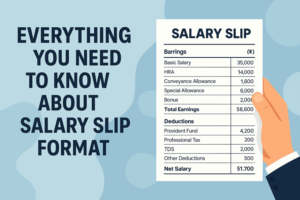
Setting the Foundation
Why ₹50 Lakh in Five Years Is a Realistic Goal
₹50 lakh might feel big, but with the right mix of discipline, tools, and action, it’s an absolutely achievable number. And you don’t need a massive salary or a windfall gain. You need a working plan and the discipline to stick to it.
Think about it: ₹50 lakh in five years breaks down to ₹10 lakh per year. That’s about ₹83,000 per month. If you invest in the right growth vehicles, you don’t have to save that entire amount. Your money can help you build the rest; that’s the game.
Key Financial Principles to Understand
Before diving into strategies, you need to get these basics right:
- Earning is your first fuel. The more you grow your income, the faster you hit the target.
- Saving gives you capital to invest.
- Investing multiplies your effort.
- Tracking keeps you aligned.
Every rupee should either earn or rest with purpose. Your savings account just won’t be enough.
The Power of Compounding Explained
Compounding is when your money earns interest, and the earnings also start earning. Over time, this snowballs into real wealth. You invest ₹30,000 a month, earn 12% annually, and you’re already close to ₹50 Lakh in 5 years. Compounding rewards patience. That’s why the earlier you start, the better it works.
Strategy 1: High-Yield Investment Plans
Equity Mutual Funds (SIP Approach)
This option is simple and effective. You can opt for Systematic Investment Plans (SIPs) in equity mutual funds. With this approach, you can invest small amounts every month into high-growth companies. In the past, many good-quality mutual funds have given 12 to 14% annual returns.
SIPs also bring rupee-cost averaging. Result? You will be investing in a disciplined manner with a fixed amount every month. You will buy fewer mutual fund units when the price is high and buy more when the price is low. So if you start early and stay consistent, you’ll be amazed at how fast your required fund will build up.
Direct Stock Market Investments
Let’s say you have an excellent risk appetite and you love numbers. Then the stock market could be a good alternative for you. You can use it to grow your returns higher. You can invest in solid companies with promising growth and ride the market.
But this needs solid homework. Understand the company, the sector, and the numbers. Stick to large-cap or quality mid-cap stocks if you’re new. Use platforms that help you track fundamentals and updates.
ELSS and Tax-Saving Mutual Funds
Equity Linked Saving Schemes (ELSS) give you equity growth plus tax savings under Section 80C. The only downside here is a lock-in period. They come with a 3-year lock-in and provide exposure to equities. But they make a strong combo of tax efficiency and wealth creation.
If you’re targeting ₹50 lakh and also looking to trim your tax outgo, ELSS is an efficient way to go.
Strategy 2: Side Hustles and Business Ventures
Freelancing and Consulting Work
Got a skill? Use it. Writing, coding, designing, marketing, finance, editing, and freelance gigs are everywhere now. You don’t need to leave your job. Just take 1–2 hours daily and offer your skills online.
Even ₹25,000 extra per month from freelancing can change your math. Over five years, that alone adds ₹15 lakh if you save and invest it.
Starting a Scalable Online Business
Start something that grows beyond your time. It could be a niche e-commerce store, a print-on-demand brand, or digital products. Start lean, use automation tools, and focus on scale, not perfection.
Margins stay high when you build something digital. A business that earns ₹50,000 per month within a year adds serious power to your five-year wealth goal.
Monetizing Skills on Digital Platforms
YouTube, Instagram, LinkedIn, or Substack—all these platforms offer monetization opportunities. Create content using your skill sets and build an audience. You earn through ads, sponsorships, affiliate links, or paid products.
It takes time to grow, but once the engine kicks in, it keeps going.
Strategy 3: Real Estate and Asset Allocation
Investing in High-Growth Properties
Real estate offers solid capital appreciation, especially in upcoming micro-markets. If you spot a zone getting metro connectivity, IT parks, or industrial zones, there’s growth waiting.
With down payment, EMI, and rental yield working together, real estate builds long-term equity while giving a monthly income. But pick the right property. Research, visit, negotiate, and hold for the five-year plan.
REITs and Rental Yield Strategies
Real Estate Investment Trusts (REITs) are like mutual funds for property. You invest small, earn rent-backed payouts, and enjoy steady appreciation.
Perfect if you want to tap into commercial real estate without buying an entire property. Some REITs even offer quarterly income. Use them to diversify your equity-heavy portfolio.
Monthly Savings Required to Reach ₹50 Lakh
SIP Calculation Table (Different Expected Returns)
Let’s run the numbers.
To hit ₹50 lakh in five years, your monthly investment depends on how well your money works for you. Different investments give different returns. Here’s how it plays out across standard growth rates:
| Expected Return | Monthly Investment (₹) | Corpus After 5 Years |
|---|---|---|
| 10% | ₹62,000 | ₹50 Lakh |
| 12% | ₹57,000 | ₹50 Lakh |
| 14% | ₹52,000 | ₹50 Lakh |
| 16% | ₹47,000 | ₹50 Lakh |
Even at 12%, which is a comfortable zone for many equity mutual funds, putting away ₹57,000 a month gets you right on track. If your investments work a little harder, say 14% or 16%, your monthly load drops. That frees up space for other moves like side hustles or short-term trades.
SIP calculators available online can help you with the math and set realistic goals. Understanding your numbers gives you direction, and that’s half the battle won.
Example Scenarios for ₹20k, ₹30k, ₹50k Monthly Investment
Let’s say you don’t have ₹57,000 right now. No stress. Start smaller and stack smart.
- ₹20,000/month @ 12% return
Over five years, this builds up to around ₹17.3 Lakh. It covers about 35% of the goal. If you add a side hustle or scale your SIP over time, you can still close the gap. - ₹30,000/month @ 12% return
This grows to ₹26 lakh in 5 years. That’s over halfway there. With some yearly top-ups, tax refunds, or a bonus deployed smartly, you’re suddenly looking at ₹35–40 Lakh. - ₹50,000/month @ 12% return
This hits ₹43.5 lakh by year five. Add even a modest 15% hike in SIP every year and you’ll cross ₹50 Lakh with room to spare.
The bottom line? Start where you are. Grow your income. Invest every extra rupee. ₹50 lakh is just consistent action away.
Risk Management and Diversification
Balancing Risk and Return
The ₹50 lakh goal isn’t just about growing fast; it’s about growing right. That means finding your comfort zone between risk and return. Don’t throw your entire monthly investment into one asset. Spread it smart.
Start with equity mutual funds. They offer strong long-term returns and fit well for a five-year horizon. Add index funds if you want lower fees and wider market exposure. Then, build in some gold ETFs, or even Sovereign Gold Bonds. Gold doesn’t always move with the stock market, which helps balance the ride.
Want stability? Add short-term debt funds or fixed deposits. They won’t shoot up fast, but they protect your base.
This mix gives you flexibility. When equity dips, gold or debt might stay strong. When markets rise, your aggressive side brings gains. This approach keeps your portfolio breathing in every market mood.
Diversification isn’t about playing safe, it’s about playing smart. Every asset has its rhythm. Your job is to keep them in tune.
Emergency Fund and Insurance Cover
Before you run the ₹50 lakh marathon, wear the right shoes. That starts with an emergency fund.
Keep at least ₹1–2 Lakh parked in a savings account or a liquid mutual fund. It should be easy to access but separate from your investments. This cushion handles job shifts, car repairs, or health surprises without shaking your core plan.
Next, protect your income. Term life insurance gives your family a payout if something unexpected happens. Health insurance keeps your finances strong when medical bills show up. Use online comparison sites to find the best premiums, coverage, and claim ratios.
Once these bases are covered, your monthly investments stay safe, untouched, and compounding, exactly how you want them.
Avoiding Common Financial Mistakes
Money grows when you treat it with respect. That means keeping your head clear and your actions consistent.
Skip tips from random YouTube channels or Telegram groups. Focus on funds and stocks with long-term track records and verified data.
Don’t borrow to invest. You want your returns to feel like gains, not repayments. If you use credit cards or loans to fund market entries, you build pressure that kills progress.
Stay hands-off with your investments unless it’s time to rebalance. Don’t withdraw to buy gadgets, vacation packages, or lifestyle upgrades. Create a separate budget for that, outside of your wealth plan.
Finally, track every move. Review your SIPs, expenses, and net worth at least once a month. When you keep your eyes on your money, it behaves better.
Solid risk management gives you confidence to stay in the game. And over 5 years, confidence compounds better than any return calculator ever could.
Realistic Roadmap and Timeline
Year-by-Year Progress Check
Here’s a sample 5-year progress line assuming ₹50,000/month @ 12% return:
- End of Year 1: ₹6.4 Lakh
- End of Year 2: ₹13.6 Lakh
- End of Year 3: ₹22.1 Lakh
- End of Year 4: ₹32.1 Lakh
- End of Year 5: ₹43.5 Lakh
Add in tax refunds, bonuses, or side income, and you easily cross ₹50 lakh.
Review and Rebalance Strategy
Every six months or so, check where you stand. Shift money between funds, adjust SIPs, or top up your savings when income grows. Rebalancing keeps the portfolio aligned with the goal.
If your equity-heavy side grew too fast, move a portion to safer assets. If real estate is lagging, pause new additions and refocus on high-yield funds.
Conclusion
₹50 Lakh in 5 years sounds ambitious. But it’s just math, consistency, and mindset.
You don’t need a massive salary. You need solid savings, smart investments, side hustle income, and a serious game plan. And you need to track it like your fitness or business targets.
Start where you are. Use what you have. Add to it each month. Watch how ₹50 lakh builds itself, one decision, one deposit, one year at a time.
FAQs:
Is it possible to make ₹50 lakh in 5 years with a salary under ₹50,000/month?
Yes. Start with smaller SIPs, grow your income through freelancing or side gigs, and reinvest any bonuses or tax refunds. Smart money habits can close the gap faster than you think.
What is the safest way to build ₹50 lakh in 5 years?
Use a mix of equity mutual funds, recurring SIPs, and asset-backed options like gold or REITs. Build an emergency fund and add insurance to protect against any unforeseen events.
Can mutual funds alone help me reach ₹50 lakh?
Yes, if you invest ₹50,000–₹57,000 per month in well-performing equity funds. SIPs offer solid growth, lower entry barriers, and good compounding over five years.
How much do I need to save per month to reach ₹50 lakh?
At a 12% annual return, ₹57,000/month takes you there in five years. If returns are higher or you start with a lump sum, the required monthly amount drops.
What are some passive income ideas to accelerate my ₹50 lakh goal?
Create digital products, rent out property or equipment, start a YouTube channel, earn affiliate income, or invest in dividend-paying assets that grow without daily effort.
Should I invest in stocks or mutual funds for this goal?
Mutual funds give structure and are great for busy investors. Stocks can bring higher returns if you enjoy research and risk-taking. You can also do both in the right balance.
How do taxes affect my ₹50 lakh goal?
Taxes on capital gains and dividends can slow down your journey toward achieving your target corpus. Use ELSS for tax savings, hold long-term for indexation benefits, and track your tax outflows as part of your goal.







